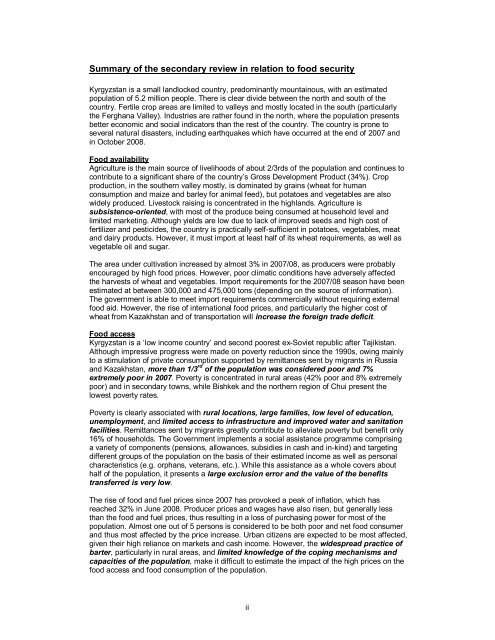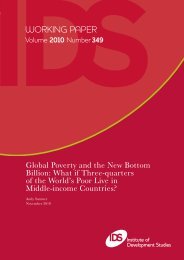secondary data review on the food security situation in the kyrgyz ...
secondary data review on the food security situation in the kyrgyz ...
secondary data review on the food security situation in the kyrgyz ...
Create successful ePaper yourself
Turn your PDF publications into a flip-book with our unique Google optimized e-Paper software.
Summary of <strong>the</strong> <str<strong>on</strong>g>sec<strong>on</strong>dary</str<strong>on</strong>g> <str<strong>on</strong>g>review</str<strong>on</strong>g> <strong>in</strong> relati<strong>on</strong> to <strong>food</strong> <strong>security</strong>Kyrgyzstan is a small landlocked country, predom<strong>in</strong>antly mounta<strong>in</strong>ous, with an estimatedpopulati<strong>on</strong> of 5.2 milli<strong>on</strong> people. There is clear divide between <strong>the</strong> north and south of <strong>the</strong>country. Fertile crop areas are limited to valleys and mostly located <strong>in</strong> <strong>the</strong> south (particularly<strong>the</strong> Ferghana Valley). Industries are ra<strong>the</strong>r found <strong>in</strong> <strong>the</strong> north, where <strong>the</strong> populati<strong>on</strong> presentsbetter ec<strong>on</strong>omic and social <strong>in</strong>dicators than <strong>the</strong> rest of <strong>the</strong> country. The country is pr<strong>on</strong>e toseveral natural disasters, <strong>in</strong>clud<strong>in</strong>g earthquakes which have occurred at <strong>the</strong> end of 2007 and<strong>in</strong> October 2008.Food availabilityAgriculture is <strong>the</strong> ma<strong>in</strong> source of livelihoods of about 2/3rds of <strong>the</strong> populati<strong>on</strong> and c<strong>on</strong>t<strong>in</strong>ues toc<strong>on</strong>tribute to a significant share of <strong>the</strong> country’s Gross Development Product (34%). Cropproducti<strong>on</strong>, <strong>in</strong> <strong>the</strong> sou<strong>the</strong>rn valley mostly, is dom<strong>in</strong>ated by gra<strong>in</strong>s (wheat for humanc<strong>on</strong>sumpti<strong>on</strong> and maize and barley for animal feed), but potatoes and vegetables are alsowidely produced. Livestock rais<strong>in</strong>g is c<strong>on</strong>centrated <strong>in</strong> <strong>the</strong> highlands. Agriculture issubsistence-oriented, with most of <strong>the</strong> produce be<strong>in</strong>g c<strong>on</strong>sumed at household level andlimited market<strong>in</strong>g. Although yields are low due to lack of improved seeds and high cost offertilizer and pesticides, <strong>the</strong> country is practically self-sufficient <strong>in</strong> potatoes, vegetables, meatand dairy products. However, it must import at least half of its wheat requirements, as well asvegetable oil and sugar.The area under cultivati<strong>on</strong> <strong>in</strong>creased by almost 3% <strong>in</strong> 2007/08, as producers were probablyencouraged by high <strong>food</strong> prices. However, poor climatic c<strong>on</strong>diti<strong>on</strong>s have adversely affected<strong>the</strong> harvests of wheat and vegetables. Import requirements for <strong>the</strong> 2007/08 seas<strong>on</strong> have beenestimated at between 300,000 and 475,000 t<strong>on</strong>s (depend<strong>in</strong>g <strong>on</strong> <strong>the</strong> source of <strong>in</strong>formati<strong>on</strong>).The government is able to meet import requirements commercially without requir<strong>in</strong>g external<strong>food</strong> aid. However, <strong>the</strong> rise of <strong>in</strong>ternati<strong>on</strong>al <strong>food</strong> prices, and particularly <strong>the</strong> higher cost ofwheat from Kazakhstan and of transportati<strong>on</strong> will <strong>in</strong>crease <strong>the</strong> foreign trade deficit.Food accessKyrgyzstan is a ‘low <strong>in</strong>come country’ and sec<strong>on</strong>d poorest ex-Soviet republic after Tajikistan.Although impressive progress were made <strong>on</strong> poverty reducti<strong>on</strong> s<strong>in</strong>ce <strong>the</strong> 1990s, ow<strong>in</strong>g ma<strong>in</strong>lyto a stimulati<strong>on</strong> of private c<strong>on</strong>sumpti<strong>on</strong> supported by remittances sent by migrants <strong>in</strong> Russiaand Kazakhstan, more than 1/3 rd of <strong>the</strong> populati<strong>on</strong> was c<strong>on</strong>sidered poor and 7%extremely poor <strong>in</strong> 2007. Poverty is c<strong>on</strong>centrated <strong>in</strong> rural areas (42% poor and 8% extremelypoor) and <strong>in</strong> <str<strong>on</strong>g>sec<strong>on</strong>dary</str<strong>on</strong>g> towns, while Bishkek and <strong>the</strong> nor<strong>the</strong>rn regi<strong>on</strong> of Chui present <strong>the</strong>lowest poverty rates.Poverty is clearly associated with rural locati<strong>on</strong>s, large families, low level of educati<strong>on</strong>,unemployment, and limited access to <strong>in</strong>frastructure and improved water and sanitati<strong>on</strong>facilities. Remittances sent by migrants greatly c<strong>on</strong>tribute to alleviate poverty but benefit <strong>on</strong>ly16% of households. The Government implements a social assistance programme compris<strong>in</strong>ga variety of comp<strong>on</strong>ents (pensi<strong>on</strong>s, allowances, subsidies <strong>in</strong> cash and <strong>in</strong>-k<strong>in</strong>d) and target<strong>in</strong>gdifferent groups of <strong>the</strong> populati<strong>on</strong> <strong>on</strong> <strong>the</strong> basis of <strong>the</strong>ir estimated <strong>in</strong>come as well as pers<strong>on</strong>alcharacteristics (e.g. orphans, veterans, etc.). While this assistance as a whole covers abouthalf of <strong>the</strong> populati<strong>on</strong>, it presents a large exclusi<strong>on</strong> error and <strong>the</strong> value of <strong>the</strong> benefitstransferred is very low.The rise of <strong>food</strong> and fuel prices s<strong>in</strong>ce 2007 has provoked a peak of <strong>in</strong>flati<strong>on</strong>, which hasreached 32% <strong>in</strong> June 2008. Producer prices and wages have also risen, but generally lessthan <strong>the</strong> <strong>food</strong> and fuel prices, thus result<strong>in</strong>g <strong>in</strong> a loss of purchas<strong>in</strong>g power for most of <strong>the</strong>populati<strong>on</strong>. Almost <strong>on</strong>e out of 5 pers<strong>on</strong>s is c<strong>on</strong>sidered to be both poor and net <strong>food</strong> c<strong>on</strong>sumerand thus most affected by <strong>the</strong> price <strong>in</strong>crease. Urban citizens are expected to be most affected,given <strong>the</strong>ir high reliance <strong>on</strong> markets and cash <strong>in</strong>come. However, <strong>the</strong> widespread practice ofbarter, particularly <strong>in</strong> rural areas, and limited knowledge of <strong>the</strong> cop<strong>in</strong>g mechanisms andcapacities of <strong>the</strong> populati<strong>on</strong>, make it difficult to estimate <strong>the</strong> impact of <strong>the</strong> high prices <strong>on</strong> <strong>the</strong><strong>food</strong> access and <strong>food</strong> c<strong>on</strong>sumpti<strong>on</strong> of <strong>the</strong> populati<strong>on</strong>.ii
















